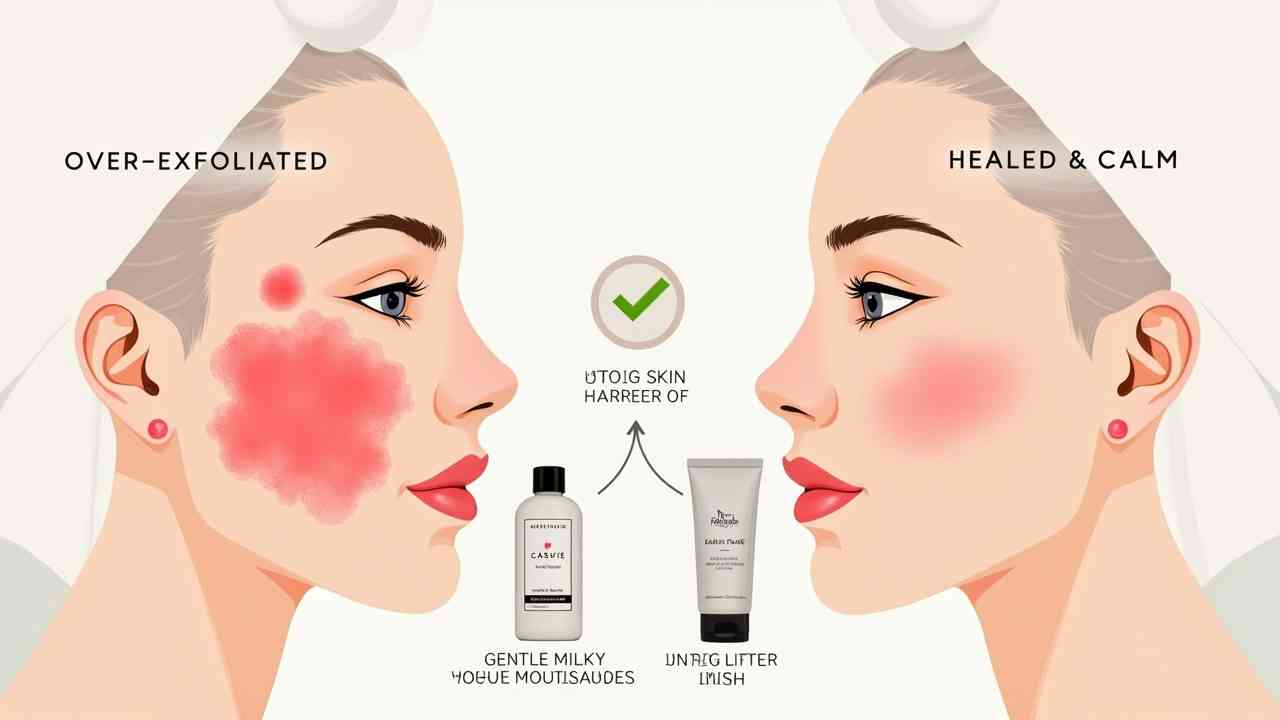
SOS! A Guide to Healing Over-Exfoliated Skin (A Dermatologist's Plan)
SOS! A Dermatologist's Guide to Healing Over-Exfoliated Skin SOS!
In the quest for a smooth, radiant complexion, it is easy to get a little too enthusiastic. We see amazing ingredients like exfoliating acids and retinoids, and we want to use them all. But more is not always better. This can lead to a very common and painful problem: over-exfoliated skin.
If your skin is suddenly angry, red, and sensitive, you may have pushed it too far. You have damaged your skin's protective barrier. The great news is that this is a fixable problem. With a gentle approach, you can get your skin back to a calm and healthy state.
This guide will explain the signs of over-exfoliation. We will also provide a simple, step-by-step healing plan. Let's get your skin on the road to recovery. ✅
🤔 First, What Are the Telltale Signs of Over-Exfoliation?
When you over-exfoliate, you are stripping away your skin's natural protective barrier. This leaves your skin vulnerable and irritated. The signs are usually very clear and uncomfortable. They can include:
- Redness and Inflammation: Your skin looks red and feels sensitive to the touch.
- Stinging or Burning: Even simple, gentle products that you normally love can suddenly cause a stinging sensation.
- A Tight, Waxy, or Shiny Appearance: Your skin might have an unnatural, tight sheen, like a piece of plastic.
- Increased Dryness and Flaking: Your skin might feel dehydrated and start to peel.
- An Increase in Breakouts: A damaged barrier can lead to more acne.
- The 4-Step Healing Action Plan
If you recognize these symptoms, you must start your recovery plan immediately. The goal is to be as gentle as possible. You need to stop the irritation and rebuild your barrier. This is your simple plan for healing over-exfoliated skin.
Step 1: Stop All Exfoliation Immediately!
This is the most critical step. You must stop using all of your exfoliating and active ingredients. This means:
- No exfoliating acids (AHAs like glycolic acid, BHAs like salicylic acid).
- No retinoids (retinol, tretinoin).
- No physical scrubs.
- No Vitamin C serums.
Your skin is injured. You must stop the assault. This is non-negotiable for healing.
Step 2: Switch to a Gentle, Milky Cleanser
Put away any foaming or acne-fighting cleansers. For now, you need to use the gentlest cleanser you can find. A creamy, milky, or hydrating gel cleanser is perfect. It should be pH-balanced and fragrance-free. Your skin should feel soft after washing, never tight.
Step 3: Focus on a Barrier-Repair Moisturizer
This is your hero product for the next few weeks. A barrier-repair cream is more than a simple moisturizer. It is packed with ingredients that mimic your skin's natural structure. Look for a simple, bland cream with these ingredients:
- Ceramides: The #1 most important ingredient for barrier repair.
- Niacinamide: Helps to calm redness and supports ceramide production.
- Panthenol & Centella Asiatica (Cica): Fantastic soothing and healing ingredients.
Apply your moisturizer generously to damp skin, morning and night.
Step 4: Sunscreen is Your Shield ☀️
Your damaged skin is extremely vulnerable to sun damage. You must wear a gentle, broad-spectrum mineral sunscreen with at least SPF 30 every single day. A mineral sunscreen (with zinc oxide) is less likely to cause stinging on irritated skin.
⏳ How Long Does It Take to Heal?
The timeline depends on the severity of the damage. You might start to feel relief from the stinging in just a few days. However, to fully rebuild a compromised barrier, it can take anywhere from 2 to 6 weeks of a consistent, gentle routine.
Be patient with your skin. Do not rush back to your active ingredients. The cozy, less sunny days of autumn are a perfect time to focus on this healing process. Once your skin feels completely calm and healthy again, you can slowly reintroduce your actives, one at a time. ✨